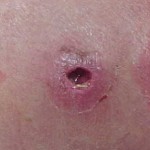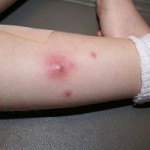MRSA Facts
What is it?
A bacterial infection that is resistant to the most common antibiotic treatment (penicillin, amoxicillin, methicillin, etc.)–no longer used for treatment. This is a rapidly progressing bacteria that attacks the soft tissue areas of the skin and can become systemic by entering the blood stream, endangering joints and vital organs.
Transmission:
Direct contact with the infected area, contact with a surface that contacted the infected area. It can live for MONTHS on surfaces and fabrics (lives in dead skin cells)!
Signs/symptoms:
Looks like a spider bite; area becomes red and hot, pustule (DO NOT POP!), may see red streaking around lesion, longer than normal healing time, unusual or unexplained pain or sensitivity, hardness in area.
Treatment:
Must see physician (may become very dangerous if it gets into the bloodstream)–culture area. Keep all suspected areas covered with a dry, clean bandage, use an antimicrobial proven to kill MRSA (may use a bleach mixture with a ratio of 9:1), evaluate vitals and inspect infected area daily.
Prevention:
- GOOD HYGIENE is the best prevention!
- Frequent hand washing or use of an alcohol-based hand sanitizer
- Cover all cuts, scrapes, rashes, skin disruptions, etc. prior to participation
- Shower after every practice and competition BEFORE leaving the facility
- Do not share personal items (razors, towels, clothing, bars of soap, etc.)
- Wash all workout gear after each practice in HOT water and detergent, dry on HOT
- Let all equipment dry thoroughly before next use (DO NOT LET IT SIT IN YOUR GYM BAG–dark and damp area perfect for breeding bacteria!)
Wipe down all equipment after each practice/competition (head gear, shoulder pads, etc.) - Clean all practice surfaces with a bleach mixture or antimicrobial proven to kill MRSA
What does it look like?


